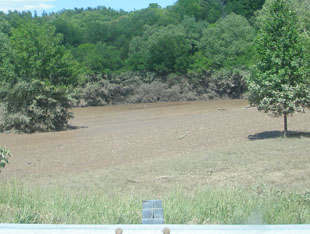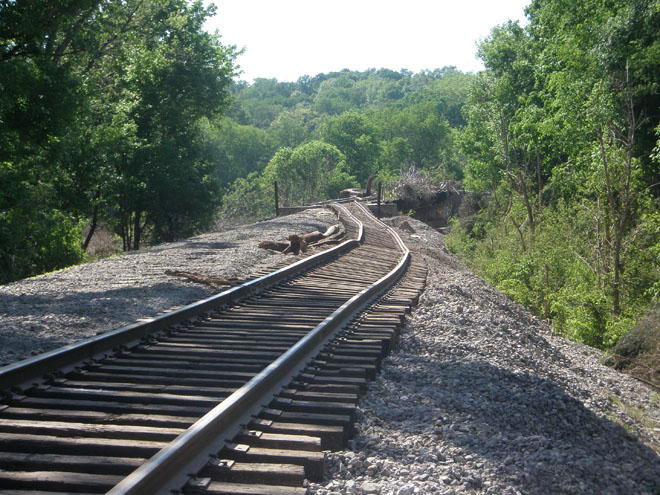Wednesday, May 5th, marks day five of the Tennessee flood of 2010, and the story continues to unfold, with each new day giving larger perspective to the magnitude of this situation. This was the first day we had a chance to go out and see some of the damage firsthand, and what we saw is hard to put into words.
Several houses near the entrance to our development had received extensive water damage, their front yards looking like random flea markets of drying household items and furniture amidst dumpsters of debris and piles of water soaked carpet mounded on the lawns. An area about two or 3 miles further west on Highway 70 was exceptionally hard hit, with debris scattered across lawns amidst more piles of water soaked housewares. Several homes had received extensive structural damage, power lines were knocked down and laying on the street amidst broken asphalt, and a couple of concrete slabs revealed the location of houses that were swept away by the raging waters.
A couple hundred feet down the train tracks from the intersection of 249 And Hwy. 70, the force of water was massive enough to move  entire sections of railroad tracks 8 feet to one side, with steel spikes ejected and lying on the ground amidst the giant steel rails, now concave and still connected to the ties. Just past the train tracks onto 249 heading towards Kingston Springs, the water line on the trees was 10 to 12 feet high, despite being a couple hundred feet from the Harpeth River, which normally flows about 15 feet below the plain.
entire sections of railroad tracks 8 feet to one side, with steel spikes ejected and lying on the ground amidst the giant steel rails, now concave and still connected to the ties. Just past the train tracks onto 249 heading towards Kingston Springs, the water line on the trees was 10 to 12 feet high, despite being a couple hundred feet from the Harpeth River, which normally flows about 15 feet below the plain.
Further down 249, just past the Kingston Springs high school, a large section of the road had been ripped up, with gigantic slabs of asphalt protruding in every direction, similar to road damage more typically associated with an earthquake. On Harpeth View Trail, a side street just past the middle school, a family could be seen sitting on the cement slab where their house once stood, one of several  houses on that street that were completely washed away. About a mile further down 249 revealed that the elementary school had been under several feet of water, as was evidenced by the brown water line on the building and surrounding trees.
houses on that street that were completely washed away. About a mile further down 249 revealed that the elementary school had been under several feet of water, as was evidenced by the brown water line on the building and surrounding trees.
In Bellevue, just a few miles away from some neighborhoods that were almost completely destroyed, I stand in front of the water damaged kempo studio adjacent to the movie theater that has also been breached. In front of the movie theater, a police car blocks traffic from going west on Highway 70, as a massive landslide has completely blocked the road. All of this damage I just described took place within 10 miles of my home in Pegram, and only represents a fraction of the total amount that happened in these communities, communities that are a small piece of a far bigger jigsaw puzzle that now has to be put back together.
During a phone call to my friend Logan, he informs me that Clarksville, his town of residence, is still near its peak flood stage, with many businesses and homes still underwater. He also confirmed the rumor that the wastewater treatment plant has been underwater since Monday, and with the plant inoperable, Clarksville’s sewage has been flowing directly in to the Cumberland River. In a news article, Tisha Calabrese-Benton, a spokeswoman for the Tennessee Department of environment and conservation, said a number of facilities upstream have been shut down as well. On the local evening news, I also learned that several counties are in a state of water emergency, as many water treatment plants have been damaged. Officials warn that while conservation efforts are underway, a stronger effort is needed.
Many that live in Tennessee, as well as other parts of the South, are always on the lookout for severe weather, with more people probably watching for tornado outbreaks than anything else. What I find most disturbing about this event was that this incomprehensible amount of damage was inflicted from a rainstorm. Even the most severe tornado outbreaks ever experienced in Tennessee pale in comparison to the amount of damage inflicted, and the total area affected by this rain event, an event that truly underscores the unyielding power of what a rainstorm can do.
2 Responses to What a Rainstorm Can Do
Leave a Reply
You must be logged in to post a comment.



I absolutely pray that the us government handles this disaster a lot better than they did with hurricane Katrina. Having made it through a flooding myself, I can tell you that it can often be genuinely devestating. Even if you’re privileged enough to be able to be able to replace the material posessions, there are always a number of items that dollars can not replace. My heart genuinely goes out to those individuals and they are in my thoughts and prayers.
Wonderful insight